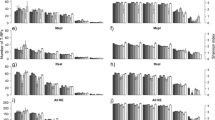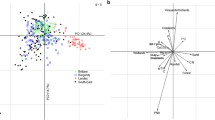Abstract
The soil functioning and the response of the biota to external perturbations such as organic input are based on multitrophic interactions among a wide range of organisms. However, the various components of the soil microflora and microfauna are rarely addressed in ecological studies. We have developed a molecular approach based on terminal restriction fragment length polymorphism (T-RFLP) analysis to assess the community structures of protozoa and nematodes, together with bacteria and fungi that share the same soil environment. Two soils were characterized by a specific fingerprint for each of the four groups of organisms, showing the potential of all T-RFLP procedures to differentiate the community structures. The response of the soil biota to organic inputs was addressed using T-RFLP fingerprints together with physiological profiles of bacteria communities and global microbial activities and densities. Although the impact of compost or manure on the soil biota was only slightly noticeable from the global parameters measured, it was obvious from the community level analyses. However, the different components of the soil biota were altered to various extents, depending on the group of organisms and the soil–organic matter combination. The potential of the T-RFLP strategy to analyze simultaneously different biotic groups from the same soil DNA extract will facilitate the more systematic integration of eukaryotic organisms in ecological studies to investigate multitrophic interactions among the microflora and microfauna in relation with soil processes.




Similar content being viewed by others
References
Anderson IC, Cairney JWG (2004) Diversity and ecology of soil fungal communities: increased understanding through the application of molecular techniques. Environ Microbiol 6:769–779
Anderson JPE, Domsch KH (1973) Quantification of fungal and bacterial contribution to soil respiration. Arch Mikrobiol 93:113–127
Avis PG, Dickie IA, Mueller GM (2006) A ‘dirty’ business: testing the limitations of terminal restriction fragment length polymorphism (TRFLP) analysis of soil fungi. Mol Ecol 15:873–882
Blanc C, Sy M, Djigal D, Brauman A, Normand P, Villenave C (2006) Nutrition on bacteria by bacterial-feeding nematodes and consequences on the structure of soil bacterial community. Eur J Soil Biol 42:S70–S78
Bonkowski M (2004) Protozoa and plant growth: the microbial loop in soil revisited. New Phytol 162:617–631
Borneman J, Hartin RJ (2000) PCR primers that amplify fungal rRNA genes from environmental samples. Appl Environ Microbiol 66:4356–4360
Braker G, Ayala-Del-Rio HL, Devol AH, Fesefeldt A, Tiedje JM (2001) Community structure of denitrifiers, Bacteria, and Archaea along redox gradients in Pacific Northwest marine sediments by terminal restriction fragment length polymorphism analysis of amplified nitrite reductase (nirS) and 16S rRNA genes. Appl Environ Microbiol 67:1893–1901
Cadet P, Berry SD, Leslie GW, Spaull VW (2007) Management of nematodes and a stalk borer by increasing within-field sugarcane cultivar diversity. Plant Pathol 56:526–535
Clarholm M (1985) Interactions of bacteria, protozoa and plants leading to mineralization of soil nitrogen. Soil Biol Biochem 17:181–187
Coleman DC, Whitman WB (2005) Linking species richness, biodiversity and ecosystem function in soil systems. Pedobiologia 49:479–497
Davet P (2004) Microbial ecology of the soil and plant growth. Science Publisher, USA
Deacon LJ, Pryce-Miller EJ, Frankland JC, Bainbridge BW, Moore PD, Robinson CH (2006) Diversity and function of decomposer fungi from a grassland soil. Soil Biol Biochem 38:7–20
Edel-Hermann V, Dreumont C, Pérez-Piquerez A, Steinberg C (2004) Terminal restriction fragment length polymorphism analysis of ribosomal RNA genes to assess changes in fungal community structure in soils. FEMS Microbiol Ecol 47:397–404
Edwards U, Rogall T, Blöcker H, Emde M, Böttger EC (1989) Isolation and direct complete nucleotide determination of entire genes. Characterization of a gene coding for 16S ribosomal DNA. Nucleic Acids Res 17:7843–7853
Elliott ET, Anderson RV, Coleman DC, Cole CV (1980) Habitable pore space and microbial trophic interactions. Oikos 35:327–335
Finlay BJ, Fenchel T (2001) Protozoan community structure in a fractal soil environment. Protist 152:203–218
Frankland JC (1998) Fungal succession—unravelling the unpredictable. Mycol Res 102:1–15
Friberg H, Lagerlof J, Ramert B (2005) Influence of soil fauna on fungal plant pathogens in agricultural and horticultural systems. Biocontrol Sci Technol 15:641–658
Garland JL (1996) Analytical approaches to the characterization of samples of microbial communities using patterns of potential C source utilization. Soil Biol Biochem 28:213–221
Kirk JL, Beaudette LA, Hart M, Moutoglis P, Khironomos JN, Lee H, Trevors JT (2004) Methods of studying soil microbial diversity. J Microbiol Methods 58:169–188
Ladd JN, Foster RC, Nannipieri P, Oades JM (1996) Soil structure and biological activity. In: Stotzky G, Bollag J-M (eds) Soil biochemistry, vol 9. Marcel Dekker, New York, pp 23–78
Liu W-T, Marsh TL, Cheng H, Forney LJ (1997) Characterization of microbial diversity by determining terminal restriction fragment length polymorphisms of genes encoding 16S rRNA. Appl Environ Microbiol 63:4516–4522
Lukow T, Dunfield PF, Liesack W (2000) Use of the T-RFLP technique to assess spatial and temporal changes in the bacterial community structure within an agricultural soil planted with transgenic and non-transgenic potato plants. FEMS Microbiol Ecol 32:241–247
Marwati U, Funasaka K, Toyota K, Katayama A (2003) Functional characterization of soil microbial communities based on the utilization pattern of aromatic compounds. Soil Sci Plant Nut 49:143–147
Mougel C, Thioulouse J, Perriere G, Nesme X (2002) A mathematical method for determining genome divergence and species delineation using AFLP. Int J Syst Evol Microbiol 52:573–586
Nannipieri P, Ascher J, Ceccherini MT, Landi L, Pietramellara G, Renella G (2003) Microbial diversity and soil functions. Eur J Soil Sci 54:655–670
Pérez-Piqueres A, Edel-Hermann V, Alabouvette C, Steinberg C (2006) Response of soil microbial communities to compost amendments. Soil Biol Biochem 38:460–470
Ranjard L, Poly F, Nazaret S (2000) Monitoring complex bacterial communities using culture-independent molecular techniques: application to soil environment. Res Microbiol 151:167–177
Rasmussen LD, Ekelund F, Hansen LH, Sorensen SJ, Johnsen K (2001) Group-specific PCR primers to amplify 24S alpha-subunit rRNA genes from Kinetoplastida (Protozoa) used in denaturing gradient gel electrophoresis. Microb Ecol 42:109–115
Regensbogenova M, Pristas P, Javorsky P, Moon-van der Staay SY, van der Staay GWM, Hackstein JHP, Newbold CJ, McEwan NR (2004) Assessment of ciliates in the sheep rumen by DGGE. Lett Appl Microbiol 39:144–147
Ros M, Klammer S, Knapp B, Aichberger K, Insam H (2006) Long-term effects of compost amendment of soil on functional and structural diversity and microbial activity. Soil Use Manag 22:209–218
Ros M, Goberna M, Pascual JA, Klammer S, Insam H (2008) 16S rDNA analysis reveals low microbial diversity in community level physiological profile assays. J Microbiol Meth 72:221–226
Schloter M, Dilly O, Munch JC (2003) Indicators for evaluating soil quality. Agric Ecosyst Environ 98:255–262
Smalla K, Wachtendorf U, Heuer H, Liu WT, Forney L (1998) Analysis of BIOLOG GN substrate utilization patterns by microbial communities. Appl Environ Microbiol 64:1220–1225
Smith SN, Pugh GJF (1979) Evaluation of dehydrogenase as a suitable indicator of soil microflora activity. Enz Microb Technol 1:279–281
Thiet RK, Frey SD, Six J (2006) Do growth yield efficiencies differ between soil microbial communities differing in fungal: bacterial ratios? Reality check and methodological issues. Soil Biol Biochem 38:837–844
Thioulouse J, Chessel D, Dolédec S, Olivier JM (1997) ADE-4: a multivariate analysis and graphical display software. Stat Comput 7:75–83
Waite IS, O’Donnell AG, Harrison A, Davies JT, Colvan SR, Ekschmitt K, Dogan H, Wolters V, Bongers T, Bongers M, Bakonyi G, Nagy P, Papatheodorou EM, Stamou GP, Bostrom S (2003) Design and evaluation of nematode 18S rDNA primers for PCR and denaturing gradient gel electrophoresis (DGGE) of soil community DNA. Soil Biol Biochem 35:1165–1173
Yang YJ, Dungan RS, Ibekwe AM, Valenzuela-Solano C, Crohn DM, Crowley DE (2003) Effect of organic mulches on soil bacterial communities one year after application. Biol Fertil Soils 38:273–281
Yeates GW (2003) Nematodes as soil indicators: functional and biodiversity aspects. Biol Fertil Soils 37:199–210
Zelenev VV, van Bruggen AHC, Leffelaar PA, Bloem J, Semenov AM (2006) Oscillating dynamics of bacterial populations and their predators in response to fresh organic matter added to soil: The simulation model ‘BACWAVE-WEB’. Soil Biol Biochem 38:1690–1711
Acknowledgements
This work was partly supported by the E.U. project RECOVEG: QLTR-01458. We thank L. Rasmussen and I. Waite for providing protozoan and nematode DNA, respectively.
Author information
Authors and Affiliations
Corresponding author
Rights and permissions
About this article
Cite this article
Edel-Hermann, V., Gautheron, N., Alabouvette, C. et al. Fingerprinting methods to approach multitrophic interactions among microflora and microfauna communities in soil. Biol Fertil Soils 44, 975–984 (2008). https://doi.org/10.1007/s00374-008-0287-1
Received:
Revised:
Accepted:
Published:
Issue Date:
DOI: https://doi.org/10.1007/s00374-008-0287-1




